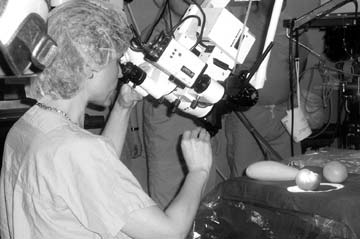Dr. Karen Kost speaks out about vocal abuse
 The latest addition to the otolaryngology department is a new CO2 laser coupled with a microscope that directs a powerful beam of light that acts as a hot knife to make precise surgical cuts and can be used to treat tumors and polyps in the nasal cavities, the mouth and vocal cords. |
For up to 18 hours a day, many of us take our most powerful communication apparatus for granted. The voice is an instrument that we all play and rely upon at work and home for everyday social interaction. In fact, professionals such as teachers, singers, actors, ministers, lawyers, journalists and telemarketers build entire careers based on the availability of their voices. Yet this vital organ is often abused and neglected.
"The voice is one of the most under-appreciated parts of our bodies," says Dr. Karen Kost, director of the MUHC Voice Laboratory. "Yet we expect it to be there from the moment we open our eyes to the moment we close them."
Ironically, this powerful and essential communication tool, the human voice, is produced by two fragile ligaments or bands of elastic muscle tissue known as the vocal cords. They are located side by side in the larynx, located behind your Adam's apple and just above the trachea (windpipe). These string-like structures can stretch and shorten as needed. When the voice is silent the vocal cords remain open creating an airway through which you breathe. During speech, the air that is exhaled from the lungs is forced through the closed vocal cords, causing them to vibrate and produce sound that rises and falls depending on how tense or relaxed the vocal cords are much like the strings of a guitar.
When used properly, in a comfortable, relaxed speaking voice, the vocal cords oscillate like graceful jellyfish, gliding together smoothly. When abused, as in shouting or excessive singing, the cords slam together violently.
"Just as you wouldn't run a marathon without preparing and training your muscles and joints, in the same way, you should not expand the use your voice without adequate practice and discipline," says Kost. "You have to train long and hard to become a vocal athlete - it doesn't happen overnight."
Most vocal cord disorders are caused by general abuse or misuse of the voice, such as shouting, singing with poor technique, excessive talking, smoking, coughing, or inadequate hydration. Vocal fatigue or overuse manifests itself as a change in the voice (often a lower pitch), hoarseness, and/or soreness and dryness of the throat. Other factors that can lead to vocal problems are: stress, lack of sleep, overworking, atmospheric dryness, talking above noisy environments, second-hand smoke, alcohol, acid reflux, pollution, allergies, moulds, and hypersensitivity to chemicals and fumes.
Some of the more common vocal cord disorders include laryngitis (inflammation or infection o the vocal cords), vocal nodules (small, hard, benign scars or calluses caused by voice abuse), and vocal polyps (small, soft, benign growths). Less common disorders such as contact ulcers and vocal cord tumors can also affect the voice. Left untreated, cancerous vocal cord tumors can become life threatening.
All of these disorders of the voice can be diagnosed and treated at the MUHC voice lab. The only complete voice lab in Montreal, this unique and vital service has been in operation since 1991. The MUHC voice lab consists of a video strobo-laryngoscopy unit, essentially a vocal-cord imaging unit. In a painless procedure that allows doctors can look at the vocal cords in action using an illuminated, non-invasive scope. The image of the cords is projected on a computer monitor where it can be further enhanced to help detect polyps, tumors, and other abnormal structures on the vocal cords.
Over 3,000 patients a year are evaluated and treated in the lab: these include professional singers, referred from the McGill and University of Montreal schools of Music, patients and vocal professionals from all over the province and international performers.
In addition, to the department has added another piece of state-of-the art equipment used in the treatment of vocal cord disorders a new CO2 laser coupled with a microscope and advanced surgical software. This new high-tech device directs a powerful beam of light that acts as a hot knife to make precise surgical cuts and can be used to treat tumors and polyps in the nasal cavities, the mouth and vocal cords.
It offers numerous advantages over conventional tools. Since surgery is performed through the oral cavities with use of the microscope, it eliminates the need to make surgical incisions through the multiple layers of tissue and muscle in the throat and neck area. Because it is a day surgery, patients return home sooner and recover faster. "This new laser is like having a pen to map out and burn away at the cancer or other abnormal structures in the mouth, nose and throat. From the most life-threatening cancers of the larynx and pharynx to the most benign polyps and papillomas, it will reduce the patients' discomfort and decrease the incidence of complications," says Kost.
Vocal hygiene
- Drink 1.5-2 litters of water daily - Vocal cords need to be hydrated
- Don't yell scream or shout. Speak to those within easy range using a moderate voice.
- Don't do all the talking. Listen and give those around you a chance to speak. Give your voice little 'mini-rests'.
- Avoid drinking caffeinated beverages like tea, coffee and soft drinks - these do not substitute for water.
- Try not to hack or repeatedly clear your throat - this slams the vocal cords together.
Listen to yourself: if your voice sounds a little tired or hoarse, and your throat is sore, chances are your vocal cords are sending a message that they are not happy. It's time for a break with a little voice rest and lots water.


